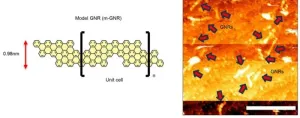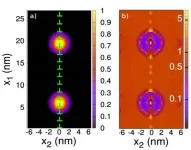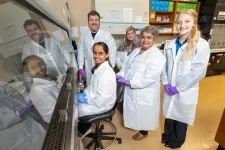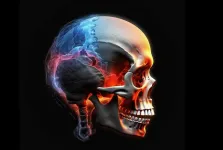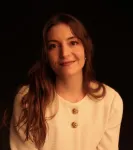(Press-News.org)
Researchers have developed a method of “wiring up” graphene nanoribbons (GNRs), a class of one-dimensional materials that are of interest in the scaling of microelectronic devices. Using a direct-write scanning tunneling microscopy (STM) based process, the nanometer-scale metal contacts were fabricated on individual GNRs and could control the electronic character of the GNRs. The researchers say that this is the first demonstration of making metal contacts to specific GNRs with certainty and that those contacts induce device functionality needed for transistor function.
The results of this research, led by electrical and computer engineering (ECE) professor Joseph Lyding, along with ECE graduate student Pin-Chiao Huang and materials science and engineering graduate student Hongye Sun, were recently published in the journal ACS Nano.
“Graphene has been around for a while and it’s been thought of as something that could potentially be a high-speed electronic material, perhaps even a replacement for silicon,” explains Lyding. “But the problem with graphene itself is that it is not a semiconductor.” Graphene is a one-atom-thick layer of carbon atoms and while it may be the thinnest known material, it is also incredibly strong. Semiconductor properties can be induced in graphene by making it very small or by fabricating it into specific shapes—like ribbons. For this project, atomically-precise GNRs were synthesized by co-author Alexander Sinitskii and his group at the University of Nebraska.
The process of making a transistor out of the GNRs includes putting them on a silicon substrate, connecting wires and running current through the wires to measure the transistor properties. The team has made the critical step of taking the GNRs, that are narrower in diameter than a DNA molecule, and wiring them up. They have developed a technique where the wires are also just a few nanometers wide.
Other researchers have worked on this problem by putting many GNRs on a silicon surface and putting down giant electrodes and hoping for the best. This method, however, introduces a lot of uncertainty. Lyding and his students used a more precise method for wiring up the GNRs. They used a scanning tunneling microscope (an atomic resolution imaging tool) to scan the surface looking for a GNR to use. In STM, a sharp tip is brought close to a surface—on the order of a nanometer—and scanned across the surface. There is a current flow between the tip and the surface, and when the tip comes across atoms on the surface, like driving over a speedbump, that current flow becomes modulated. This allows for the detection and imaging of the GNRs.
Once they find a GNR, they use the electron beam in the STM to trigger metal deposition from hafnium diboride precursor molecules to create the wires. Co-author Gregory Girolami and his group in the UIUC Chemistry Department synthesized the precursor for this process, called STM direct-write. “Our wiring method is very precise. When we see a GNR, we can just define a pattern that we want, and then we’ll connect it. It’s not just blindly throwing electrodes on the surface,” says Huang.
Another advantage of this method is that it is done in ultra-high vacuum (UHV). This ensures that the material stays clean from atmospheric water and other “junk” that degrades device performance.
The researchers also investigated the electronic character of the GNRs and found that it was changed by putting the metal contacts on. Semiconductor “doping” is the intentional introduction of impurities to change its electronic properties. Sun explains, “One way to dope GNRs is to use different chemical reactions to change the GNR properties. But that process is hard. The way we do it is by depositing metal. And we can actually choose the kind of metal that we want to put on the GNRs which could also tune the GNR characteristics. That’s one way to essentially dope our GNRs, without actually using dopants.”
Lyding says, “The next step, which we're working on now, is to make a real transistor and actually measure the transistor characteristics. But we know that we can do this pristine process, using ultra-high vacuum, of making the electrodes that are absolutely necessary for device function.”
*
Joseph Lyding is also an affiliate of the Holonyak Micro and Nanotechnology Laboratory, Coordinated Sciences Laboratory, and Beckman Institute for Advanced Science and Technology at UIUC.
Pin-Chiao Huang and Hongye Sun are also affiliates of the Holonyak Micro and Nanotechnology Laboratory at UIUC.
Other contributors to this work include Mamum Sarker (Department of Chemistry at the University of Nebraska Lincoln), Christopher M. Caroff (School of Chemical Sciences at the University of Illinois Urbana-Champaign), Gregory S. Girolami (School of Chemical Sciences at the University of Illinois Urbana-Champaign) and Alexander Sinitskii (Department of Chemistry and Nebraska Center for Materials and Nanoscience at the University of Nebraska Lincoln).
This research was funded by the Office of Naval Research (ONR), the Army Research Office (ARO) and the National Science Foundation (NSF).
END
A new type of regulation is needed to support and encourage organisations to comply with equality and human rights law because enforcement alone is ineffective, a new study says.
The introduction of the Public Sector Equality Duty and the Human Rights Act were intended to establish an equality and human rights culture within public authorities. The research highlights how this culture has failed to take hold.
An alternative is needed to the current model of regulation (the enforcement pyramid) under which penalties increasingly progress until noncompliers comply. The study says the current model cannot recognise innovation, ...
Materials are often considered to be one phase, but many engineering materials contain two or more phases, improving their properties and performance. These two-phase materials have inclusions, called precipitates, embedded in the microstructure. Alloys, a combination of two or more types of metals, are used in many applications, like turbines for jet engines and light-weight alloys for automotive applications, because they have very good mechanical properties due to those embedded precipitates. The average precipitate size, however, tends to increase ...
Using a novel deep brain stimulation (DBS) device capable of recording brain signals, researchers have identified a pattern of brain activity or “biomarker” related to clinical signs of recovery from treatment-resistant depression. The findings from this small study are an important step towards using brain data to understand a patient’s response to DBS treatment. The study was published in Nature and supported by the National Institutes of Health’s Brain Research Through Advancing ...
The Eunice Kennedy Shriver National Institute of Child Health and Human Development awarded $3.1 million to the University of Arkansas to study a spectrum of pediatric mitochondrial disorders caused by mutations in the mitochondria. These disorders often impact different organs requiring energy and can lead to mitochondria-induced multiple organ disorder syndromes, or MIMODS.
Shilpa Iyer, an associate professor of biological sciences, will serve as the principal investigator on the five-year award. Iyer and her team conduct research on mitochondrial diseases and have received grants from Arkansas ...
Craniosynostosis, the premature fusion of the top of the skull in infants, is caused by an abnormal excess of a previously unknown type of bone-forming stem cell, according to a preclinical study led by researchers at Weill Cornell Medicine.
Craniosynostosis arises from one of several possible gene mutations, and occurs in about one in 2,500 babies. By constricting brain growth, it can lead to abnormal brain development if not corrected surgically. In complex cases, multiple surgeries are needed.
In the study, which appears Sept. 20 in Nature, the researchers examined in detail what happens in the skull of mice with one of the most common mutations found in human ...
SEPTEMBER 20, 2023, NEW YORK – In exploring an aspect of how killer T cells generate the raw materials required for their proliferation, a Ludwig Cancer Research study has uncovered an unexpected link between the immune cells’ metabolism, regulation of gene expression, persistence and functional efficacy that could be exploited using existing drugs to improve cancer immunotherapy.
Researchers led by Ludwig Lausanne’s Alison Jaccard and Ping-Chih Ho along with their University of Lausanne colleagues Mathias Wenes and Pedro Romero were exploring how proliferating T cells in the low-oxygen environment of tumors make citrate, a molecule essential to manufacturing membranes, which ...
How do our muscles respond at the molecular level to exercise? Researchers at Helmholtz Munich and the German Institute of Human Nutrition Potsdam-Rehbrücke (DIfE) have unraveled the cellular basis and signaling pathways responsible for the positive impact of physical activity on our overall health. Regulatory T cells, a type of immune cell, play a critical role in ensuring proper muscle function. These novel insights are paving the path towards precision medicines targeting metabolic disorders like obesity and diabetes, as well as muscle-related illnesses. Their discoveries are published in Cell Metabolism.
Obesity and type ...
Scientists have revealed the molecular structure of a type of receptor that’s crucial to brain development and function.
Known as Type A GABA receptors, these receptors are already targeted by pharmaceutical anesthetics, sedatives and antidepressants because of their important role in brain function. The discovery, published today in the journal Nature, reveals the dominant assemblies and states of the GABA receptor, a finding that could enable the development of new compounds that more specifically target a range of medical disorders.
“It is the main player that balances excitation and inhibition in the ...
Imagine if France, Germany, and Spain were completely blanketed in forests — and then all those trees were quickly chopped down. That’s nearly the amount of deforestation that occurred globally between 2001 and 2020, with profound consequences.
Deforestation is a major contributor to climate change, producing between 6 and 17 percent of global greenhouse gas emissions, according to a 2009 study. Meanwhile, because trees also absorb carbon dioxide, removing it from the atmosphere, they help keep the Earth cooler. ...
You’re looking at a truck. You’re with a young child and he follows your gaze. He’s interested in the object you’re looking at without you pointing at it. This is called joint attention and it is one of the primary ways children learn to connect words with objects and acquire language.
Lack of joint attention is a core feature of autism. Until now, it was thought that stimulating joint attention in people with autism would help them express themselves verbally. But a meta-analysis of 71 studies on autism challenges this assumption and suggests that people with autism spectrum disorders may acquire language differently.
The study – by Laurent Mottron, ...
